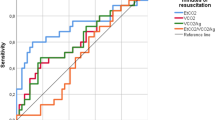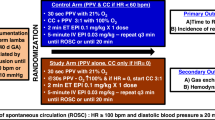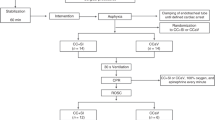Abstract
Even brief interruption of cardiac compressions significantly reduces critical coronary perfusion pressure during cardiopulmonary resuscitation (CPR). End-tidal CO2 (ETCO2) monitoring may provide a continuous noninvasive method of assessing return of spontaneous circulation (ROSC) without stopping to auscultate for heart rate (HR). However, the ETCO2 value that correlates with an audible HR is unknown. Our objective was to determine the threshold ETCO2 that is associated with ROSC after asphyxia-induced asystole. Neonatal swine (n = 46) were progressively asphyxiated until asystole occurred. Resuscitation followed current neonatal guidelines with initial ventilation with 100% O2 followed by cardiac compressions followed by epinephrine for continued asystole. HR was auscultated every 30 s, and ETCO2 was continuously recorded. A receiver operator curve was generated using the calculated sensitivity and specificity for various ETCO2 values, where a positive test was defined as the presence of HR >60 bpm by auscultation. An ETCO2 cut-off value of 14 mm Hg is the most sensitive ETCO2 value with the least false positives. When using ETCO2 to guide uninterrupted CPR in this model of asphyxia-induced asystole, auscultative confirmation of return of an adequate HR should be performed when ETCO2 ≥14 mm Hg is achieved. Correlation during human neonatal CPR needs further investigation.
Similar content being viewed by others
Log in or create a free account to read this content
Gain free access to this article, as well as selected content from this journal and more on nature.com
or
Abbreviations
- CPR:
-
cardiopulmonary resuscitation
- d :
-
distance
- ETCO2:
-
end-tidal CO2
- HR:
-
heart rate
- NRP:
-
Neonatal Resuscitation Program
- PPV:
-
positive pressure ventilation
- ROC:
-
receiver operator characteristic
- ROSC:
-
return of spontaneous circulation
REFERENCES
Perlman JM, Risser R 1995 Cardiopulmonary resuscitation in the delivery room. Arch Pediatr Adolesc Med 149: 20–25
Wyckoff MH, Perlman JM, Laptook AR 2005 Use of volume expansion during delivery room resuscitation in near-term and term infants. Pediatrics 115: 950–955
Barber CA, Wyckoff MH 2006 Endotracheal versus intravenous epinephrine during neonatal cardiopulmonary resuscitation in the delivery room. Pediatrics 118: 1028–1034
Ralston SH, Voorhees WD, Babbs CF 1984 Intrapulmonary epinephrine during prolonged cardiopulmonary resuscitation: improved regional flow and resuscitation in dogs. Ann Emerg Med 13: 79–86
Sanders AB, Ewy GA, Taft TV 1984 Prognostic and therapeutic importance of the aortic diastolic pressure in resuscitation from cardiac arrest. Crit Care Med 12: 871–873
Niemann JT, Criley JM, Rosborough JP, Niskanen RA, Alferness C 1985 Predictive indices of successful cardiac resuscitation. Ann Emerg Med 14: 521–528
Halperin HR, Tsitlik JE, Guerci AD, Mellits ED, Levin HR, Shi A-Y, Chandra N, Weisfeldt ML 1986 Determinants of blood flow to vital organs during cardiopulmonary resuscitation in dogs. Circulation 73: 539–550
Kern KB, Hilwig RW, Berg RA, Ewy GA 1998 Efficacy of chest compression-only BLS CPR in the presence of an occluded airway. Resuscitation 39: 179–188
Berg RA, Sanders AB, Kern KB, Hilwig RW, Heidenreich JW, Porter ME, Ewy GA 2001 Adverse effects of interrupting chest compressions for rescue breathing during cardiopulmonary resuscitation for ventricular fibrillation cardiac arrest. Circulation 104: 2465–2470
Kern KB, Hilwig RW, Berg RA, Sanders AB, Ewy GA 2002 Importance of continuous chest compressions during cardiopulmonary resuscitation: improved outcome during a simulated single lay-rescuer scenario. Circulation 105: 645–649
ECC Committee Subcommittees and Task Forces of the American Heart Association 2005 2005 American Heart Association guidelines for cardiopulmonary resuscitation and emergency cardiovascular care. Part 3. Overview of CPR. Circulation 112: IV-12–IV-18
Sayre MR, Berg RA, Cave DM, Page RL, Potts J, White RD 2008 Hands-only (compression-only) cardiopulmonary resuscitation: a call to action for bystander response to adults who experience out-of-hospital sudden cardiac arrest: a science advisory for the public from the American Heart Association Emergency Cardiovascular Care Committee. Circulation 117: 2162–2167
Kattwinkel J 2006 Textbook of Neonatal Resuscitation. 5th ed. American Academy of Pediatrics/American Heart Association, Elk Grove, IL, pp, 10–20
Weil MH, Bisera J, Trevino RP, Rackow EC 1985 Cardiac output and end-tidal carbon dioxide. Crit Care Med 13: 907–909
Trevino RP, Bisera J, Weil MH, Rackow EC, Grundler WG 1985 End-tidal CO2 as a guide to successful cardiopulmonary resuscitation: a preliminary report. Crit Care Med 13: 910–911
Garnett AR, Ornato JP, Gonzalez ER, Johnson EB 1987 End-tidal carbon dioxide monitoring during cardiopulmonary resuscitation. JAMA 257: 512–515
Falk JL, Rackow EC, Weil MH 1988 End-tidal carbon dioxide concentration during cardiopulmonary resuscitation. N Engl J Med 318: 607–611
Kern KB, Sanders AB, Voorhees WD, Babbs CF, Tacker WA, Ewy GA 1989 Changes in expired end-tidal carbon dioxide during cardiopulmonary resuscitation in dogs: a prognostic guide for resuscitation efforts. J Am Coll Cardiol 13: 1184–1189
Bhende MS 2001 End-tidal carbon dioxide monitoring in pediatrics—concepts and technology. J Postgrad Med 47: 153–156
Sanders AB, Kern KB, Otto CW, Milander MM, Ewy GA 1989 End-tidal carbon dioxide monitoring during cardiopulmonary resuscitation. JAMA 262: 1347–1351
Idris AH, Staples ED, O'Brien DJ, Melker RJ, Rush WJ, Del Duca KD, Falk JL 1994 End-tidal carbon dioxide during extremely low cardiac output. Ann Emerg Med 23: 568–572
Bhende MS, Karasic DG, Karasic RB 1996 End-tidal carbon dioxide changes during cardiopulmonary resuscitation after experimental asphyxial cardiac arrest. Am J Emerg Med 14: 349–350
Ewy GA, Zuercher M, Hilwig RW, Sanders AB, Berg RA, Otto CW, Hayes MM, Kern KB 2007 Improved neurological outcome with continuous chest compressions compared with 30:2 compressions-to-ventilations cardiopulmonary resuscitation in a realistic swine model of out-of-hospital cardiac arrest. Circulation 116: 2525–2530
Wyckoff MH, Berg RA 2008 Optimizing chest compressions during delivery room resuscitation. Semin Fetal Neonatal Med 13: 410–415
Callaham M, Barton C 1990 Prediction of outcome of cardiopulmonary resuscitation from end-tidal carbon dioxide concentration. Crit Care Med 18: 358–362
Domsky M, Wilson RF, Heins J 1995 Intraoperative end-tidal carbon dioxide values and derived calculations correlated with outcome: prognosis and capnography. Crit Care Med 23: 1497–1503
Sanders AB, Ewy GA, Bragg S, Atlas M, Kern KB 1985 Expired PCO2 as a prognostic indicator of successful resuscitation from cardiac arrest. Ann Emerg Med 14: 948–952
Gudipati CV, Weil MH, Bisera J, Deshmukh HG, Rackow EC 1988 Expired carbon dioxide: a noninvasive monitor of cardiopulmonary resuscitation. Circulation 77: 234–239
Berg RA, Henry C, Otto CW, Sanders AB, Kern KB, Hilwig RW, Ewy GA 1996 Initial end-tidal CO2 is markedly elevated during cardiopulmonary resuscitation after asphyxial cardiac arrest. Pediatr Emerg Care 12: 245–248
Behrman RE, Lees MH, Peterson EN, De Lannoy CW, Seeds AE 1970 Distribution of the circulation in the normal and asphyxiated fetal primate. Am J Obstet Gynecol 108: 956–969
Cohn HE, Sacks EJ, Heymann MA, Rudolph AM 1974 Cardiovascular responses to hypoxemia and acidemia in fetal lambs. Am J Obstet Gynecol 120: 817–824
Leffler CW, Busija DW, Beasley DG, Fletcher AM, Green RS 1986 Effects of indomethacin on cardiac output distribution in normal and asphyxiated piglets. Prostaglandins 31: 183–190
Hohimer AR, Bissonnette JM 1989 Effects of cephalic hypotension, hypertension, and barbiturates on fetal cerebral flood flow and metabolism. Am J Obstet Gynecol 161: 1344–1351
Donegan JH, Traystman RJ, Koehler RC, Jones MD Jr, Rogers MC 1985 Cerebrovascular hypoxic and autoregulatory responses during reduced brain metabolism. Am J Physiol 249: H421–H429
Steedman DJ, Robertson CE 1990 Measurement of end-tidal carbon dioxide concentration during cardiopulmonary resuscitation. Arch Emerg Med 7: 129–134
LaValle TL, Perry AG 1995 Capnography: assessing end-tidal CO2 levels. Dimens Crit Care Nurs 14: 70–77
Callaham M, Barton C, Matthay M 1992 Effect of epinephrine on the ability of end-tidal carbon dioxide readings to predict initial resuscitation from cardiac arrest. Crit Care Med 20: 337–343
Author information
Authors and Affiliations
Corresponding author
Additional information
This work was supported by an American Academy of Pediatrics Neonatal Resuscitation Program Research Grant. In addition, L.F.C. and L.H. are supported by grant KL2RR024983, titled, “North and Central Texas Clinical and Translational Science Initiative” from the National Center for Research Resources (NCRR, NIH).
Supplemental digital content is available for this article. Direct URL citations appear in the printed text and are provided in the HTML and PDF versions of this article on the journal's Web site (www.pedresearch.org).
Rights and permissions
About this article
Cite this article
Chalak, L., Barber, C., Hynan, L. et al. End-Tidal CO2 Detection of an Audible Heart Rate During Neonatal Cardiopulmonary Resuscitation After Asystole in Asphyxiated Piglets. Pediatr Res 69, 401–405 (2011). https://doi.org/10.1203/PDR.0b013e3182125f7f
Received:
Accepted:
Issue date:
DOI: https://doi.org/10.1203/PDR.0b013e3182125f7f
This article is cited by
-
Volumetric capnography and return of spontaneous circulation in an experimental model of pediatric asphyxial cardiac arrest
Scientific Reports (2023)
-
Versorgung und Reanimation des Neugeborenen nach der Geburt
Notfall + Rettungsmedizin (2021)
-
Continuous capnography monitoring during resuscitation in a transitional large mammalian model of asphyxial cardiac arrest
Pediatric Research (2017)
-
Die Versorgung und Reanimation des Neugeborenen
Notfall + Rettungsmedizin (2015)



